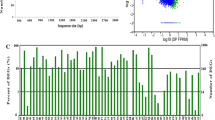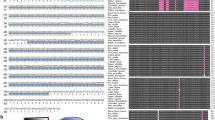Abstract
Three novel ovine genes were obtained from muscle full-length cDNA library of black-boned sheep. Sequence analysis revealed that nucleotide sequences of these genes were not homologous to any of the known sheep or goat genes, but these genes have high similarity to ATP synthase subunit O (ATP5O), NADH dehydrogenase (ubiquinone) 1 alpha subcomplex, 12 (NDUFA12) and ubiquinol-cytochrome c reductase hinge protein (UQCRH) genes of other mammal animals (accession number: FJ546085, FJ546078 and FJ546083). The alignment analysis showed that the ovine ATP5O, NDUFA12 and UQCRH genes and proteins have closer genetic relationships with the ATP5O, NDUFA12 and UQCRH genes and proteins from cattle. Conserved domain prediction showed that these three genes included OSCP, NDUFA12 superfamily and UCR-hinge superfamily domains respectively. The deduced sequence of ATP5O, NDUFA12 and UQCRH protein had 213, 145 and 91 amino acid residues, with a molecular weight of approximately 23419.66, 17089.50 and 10657.75 Da and a theoretical isoelectric point of 9.90, 9.68 and 4.45. The secondary structure prediction revealed that 60% helix structure in ATP5O, 60% coils in NDUFA12 and no strand in UQCRH. One potential signal peptide structure in ATP5O protein were found. NDUFA12 and UQCRH have the extremely low possibility of signal peptides. Meanwhile, RasMol was used for visualizing the PDB files generated by Swiss-Model in cartoon or three-dimensional format. ATP5O and UQCRH protein were modeled by Swiss-Model. Tissue expression profile indicated that the ovine ATP5O, NDUFA12 and UQCRH genes could be expressed in all detected tissues including muscles, heart, liver, spleen, lung, kidney and adipose tissues, but the expression abundance of these genes were various in the different tissues. Our experiment supplied the primary foundation for further researches on these three ovine genes.





Similar content being viewed by others
References
Hu H, Liu YG, Zhao SM, Deng WD, Gao SZ (2009) Molecular characterization and tissue expression of ovine PSAM6 gene from muscle Full-Length cDNA library of Black-Boned Sheep. Anim Biotechnol 20(4):238–241
DiMauro S, Schon EA (2003) Mitochondrial respiratory-chain diseases. N Engl J Med 348:2656–2668
Rönn T, Poulsen P, Tuomi T, Isomaa B, Groop L, Vaag A, Ling C (2009) Genetic variation in ATP5O is associated with skeletal muscle ATP50 mRNA expression and glucose uptake in young twins. PLoS ONE 4(3):e4793
Ostergaard E, Rodenburg RJ, van den Brand M, Thomsen LL, Duno M, Batbayli M, Wibrand F, Nijtmans L (2011) Respiratory chain complex I deficiency due to NDUFA12 mutations as a new cause of Leigh syndrome. J Med Genet. doi:10.1136/jmg.2011.088856
Modena P, Testi MA, Facchinetti F, Mezzanzanica D, Radice MT, Pilotti S, Sozzi G (2003) UQCRH gene encoding mitochondrial Hinge protein is interrupted by a translocation in a soft-tissue sarcoma and epigenetically inactivated in some cancer cell lines. Oncogene 22:4586–4593
Garbian Y, Ovadia O, Dadon S, Mishmar D (2010) Gene expression patterns of oxidative phosphorylation complex I subunits are organized in clusters. PLoS ONE 5(4):e9985
Devenish RJ, Prescott M, Boyle GM, Nagley P (2000) The oligomycin axis of mitochondrial atp synthase: OSCP and the proton channel. J Bioenerg Biomembr 32:507–515
Bjellqvist B, Hughes GJ, Pasquali CH, Paquet N, Ravier F, Sanchez JCH, Frutiger S, Hochstrasser DF (1993) The focusing positions of polypeptides in immobilized pH gradients can be predicted from their amino acid sequences. Electrophoresis 14:1023–1031
Bryson K, McGuffin LJ, Marsden RL, Ward JJ, Sodhi JS, Jones DT (2005) Protein structure prediction servers at University College London. Nucleic Acids Res 33(Web Server issue):W36–W38
Bendtsen JD, Nielsen H, von Heijne G, Brunak S (2004) Improved prediction of signal peptides: SignalP 3.0. J Mol Biol 340:783–795
Hofmann K, Stoffel W (1993) TMbase—a database of membrane spanning proteins segments. Biol Chem Hoppe-Seyler 374:166
Arnold K, Bordoli L, Kopp J, Schwede T (2006) The SWISS-MODEL Workspace: a web-based environment for protein structure homology modelling. Bioinformatics 22:195–201
Zhao S, Ma H, Zou S, Chen W (2007) Effects of in ovo administration of DHEA on lipid metabolism and hepatic lipogenetic genes expression in broiler chickens during embryonic development. Lipids 42:749–775
Berg JM, Tymoczko JL, Stryer L (2002) Biochemistry, 5th edn. WH Freeman. Co., New York
Carolyn MS, Eric AS (2000) Mitochondrial respiratory chain diseases and mutations in nuclear DNA: A Promising Start? Brain Pathol 10:442–450
Joshi S, Javed AA, Gibbs LC (1992) Oligomycin sensitivity-conferring protein (OSCP) of mitochondrial ATP synthase. The carboxyl-terminal region of OSCP is essential for the reconstitution of oligomycin-sensitive H+-ATPase. J Biol Chem 267:12860–12867
Carroll J, Fearnley IM, Skehel JM, Shannon RJ, Hirst J, Walker JE (2006) Bovine complex I is a complex of 45 different subunits. J Biol Chem 281:32724–32727
Chen H, Morris MA, Rossier C, Blouin J-L, Antonarakis SE (1995) Cloning of the cDNA for the human ATP synthase OSCP subunit (ATP50) by exon trapping and mapping to chromosome 21q22.1–q22.2. Genomics 28:470–476
Benkert P, Biasini M, Schwede T (2011) Toward the estimation of the absolute quality of individual protein structure models. Bioinformatics 27(3):343–350
Acknowledgments
This work was supported by National Key Foundation Research Development Project of China (973 Project, No. 2007CB116201).
Author information
Authors and Affiliations
Corresponding authors
Additional information
R. S. Ye and H. B. Pan have contributed equally to this work and could be regarded as the first authors.
Electronic supplementary material
Below is the link to the electronic supplementary material.
Rights and permissions
About this article
Cite this article
Ye, R.S., Pan, H.B., Yin, G.F. et al. Molecular characterization and tissue expression profile of three novel ovine genes: ATP5O, NDUFA12 and UQCRH from muscle full-length cDNA library of black-boned sheep. Mol Biol Rep 39, 5767–5774 (2012). https://doi.org/10.1007/s11033-011-1387-9
Received:
Accepted:
Published:
Issue Date:
DOI: https://doi.org/10.1007/s11033-011-1387-9




